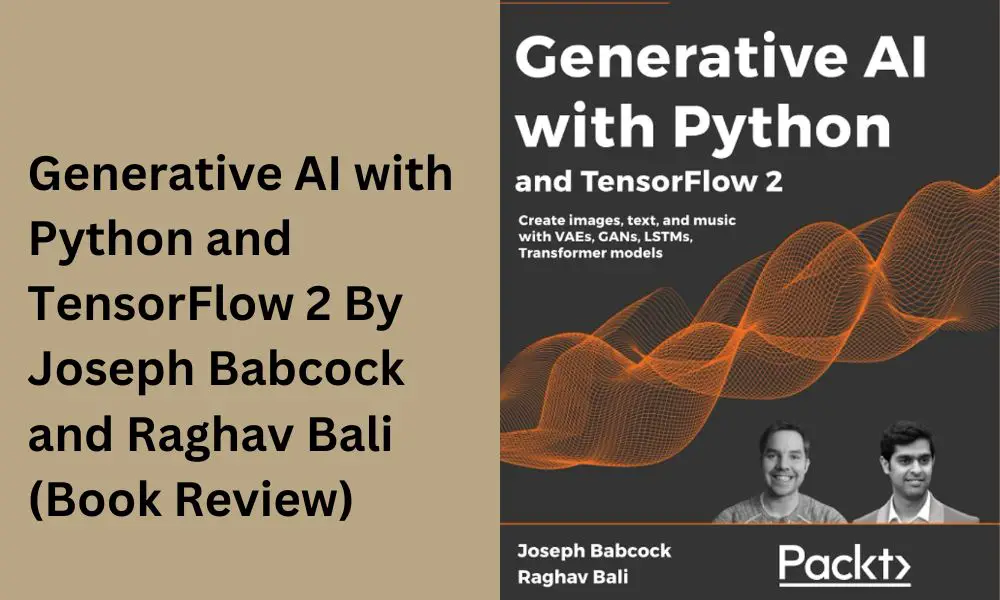Generative AI with Python and TensorFlow 2: Create images, text, and music with VAEs, GANs, LSTMs, Transformer models
Table of Contents
Introduction
Generative AI is a rapidly advancing field of artificial intelligence that allows machines to create new, original content such as images, text, and music.
Generative AI with Python and TensorFlow 2 by Joseph Babcock and Raghav Bali is a comprehensive guide that delves into the world of generative models, offering practical examples and code implementations in TensorFlow 2.
This book equips Python programmers with the knowledge and skills to build and experiment with various deep generative models like VAEs, GANs, LSTMs, and Transformer models.
In this book review, we will explore the key concepts, writing style, strengths, and areas for improvement of this guide to generative AI.
Book Summary
In Generative AI with Python and TensorFlow 2, the authors take readers on a journey through the evolution of generative models, starting from restricted Boltzmann machines and deep belief networks to modern VAEs and GANs.
The book’s content is rich and diverse, covering applications such as image generation, deepfakes, style transfer, text generation, music composition, and more.
Each chapter provides a detailed explanation of the mathematical concepts behind the models, followed by practical examples that readers can follow along to build and adapt their own generative AI models.
Book Information
Here is a table summarizing the book’s key details:
| Title | Generative AI with Python and TensorFlow 2 |
|---|---|
| Authors | Joseph Babcock and Raghav Bali |
| Publisher | Packt Publishing |
| Publish Date | April 30, 2021 |
| Pages | 488 |
| Language | English |
| Print Length | 7.5 x 1.1 x 9.25 inches |
| Formats available | Kindle, Paperback |
| Average Customer Rating | 4.1 out of 5 stars |
Overview of the Book
Generative AI with Python and TensorFlow 2 starts with an introduction to generative AI and the distinction between generative and discriminative models. The authors then guide readers through setting up a TensorFlow lab, providing detailed instructions on installing the necessary tools and libraries for a seamless development environment.
The book’s core chapters cover the building blocks of deep neural networks, teaching networks to generate digits, and creating images using VAEs and GANs. It dives into exciting applications like style transfer, deepfakes, and text generation using transformers. Readers will also explore composing music with generative models and playing video games with Generative Adversarial Imitation Learning (GAIL).
Key Concepts
The book does an excellent job of explaining fundamental concepts in generative AI, such as the underlying mathematics and principles behind each model. It provides clear explanations of topics like backpropagation, attention mechanisms, and transfer learning, making it accessible to both beginners and experienced practitioners.
Writing Style and Clarity
The writing style is engaging and approachable, making complex concepts easy to grasp. The authors use a friendly tone and include practical examples that enable readers to follow along and apply the techniques themselves. The code snippets are well-documented, and the explanations are supplemented with diagrams and illustrations, enhancing clarity.
Strengths of the Book
- Comprehensive Coverage: The book covers a wide range of generative models, providing readers with a holistic understanding of the field.
- Hands-on Approach: The practical examples and code implementations enable readers to experiment with generative AI and build their models.
- Diverse Applications: The book explores applications in various domains, including computer vision, natural language processing, and music generation.
- Clear Explanations: Complex concepts are explained concisely, with a focus on clarity and understanding.
Areas for Improvement
- Reinforcement Learning Chapter: The chapter on playing video games with Generative Adversarial Imitation Learning (GAIL) could be more in-depth and might benefit from additional practical examples.
- Consistency in Equation Formatting: Some equations in the book are presented as low-definition images, which can affect readability. It would be better to ensure consistent formatting throughout the text.
Who Should Read This Book
Generative AI with Python and TensorFlow 2 is a valuable resource for Python programmers interested in exploring the creative side of AI and working with generative models. It caters to both beginners and seasoned practitioners, thanks to its clear explanations and practical approach. Anyone keen to create innovative AI applications, such as deepfakes, music composition, and image generation, will find this book a valuable addition to their library.
Conclusion
Generative AI with Python and TensorFlow 2 is an excellent guide for anyone interested in diving into the fascinating world of generative models. The authors cover a wide range of models and applications, providing a well-rounded understanding of generative AI. The book’s hands-on approach and practical examples make it a valuable resource for readers looking to develop their skills in generative AI using TensorFlow 2.
FAQ
Q1: Are there any prerequisites for reading this book?
A1: While prior knowledge of Python programming is helpful, the book provides explanations and code examples that make it accessible to beginners. Familiarity with basic math and statistics for machine learning will also be beneficial.
Q2: Is the code provided in the book compatible with both TensorFlow 1 and TensorFlow 2?
A2: The book primarily focuses on TensorFlow 2, but many of the concepts and code can be adapted for TensorFlow 1 as well.
Q3: Can this book be used in academic settings or for self-study?
A3: Yes, the book is suitable for both self-study and academic purposes. The clear explanations and practical examples make it a valuable resource for learning generative AI.
Q4: Does the book cover cutting-edge research in generative AI?
A4: The book covers many foundational and popular generative models. While it may not include the very latest research at the time of reading, it provides a solid foundation for exploring cutting-edge developments in the field.
Q5: Is the book available in digital formats?
A5: Yes, Generative AI with Python and TensorFlow 2 is available in Kindle and other digital formats, in addition to the traditional paperback version.
